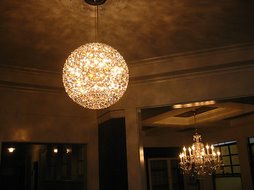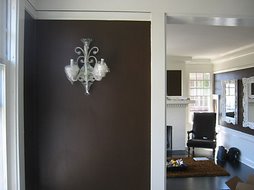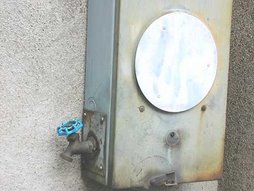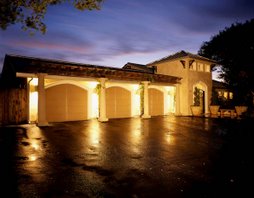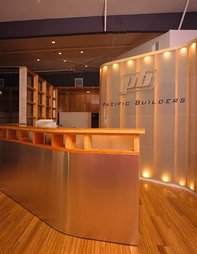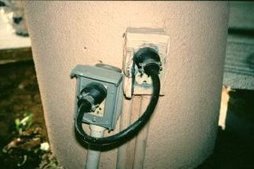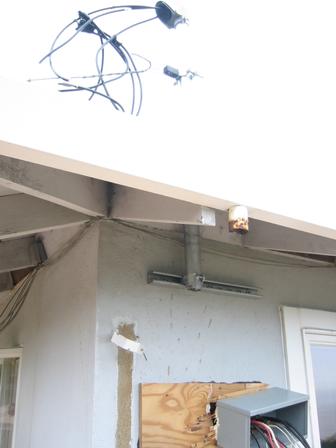
Brownout
Flickering lights. If the lights dim every time you turn on an appliance that circuit is overloaded or has a loose connection.- Your wiring should be thoroughly inspected starting at the incoming service conductors and continuing through each outlet or junction box to insure that a proper neutral path has been established for each circuit, and that all connections are tight. I have fixed this problem hundreds of times in homes here in San Anselmo.
- The Facts : December is the most dangerous month for electrical fires. Fire deaths are highest in winter months which call for more indoor activities and increase in lighting, heating, and appliance use. Most electrical wiring fires start in the bedroom.
- The Cause: Electrical Wiring
- Most electrical fires result from problems with "fixed wiring" such as faulty electrical outlets and old wiring. Problems with cords and plugs, such as extension and appliance cords, also cause many home electrical fires.
- In urban areas, faulty wiring accounts for one third of residential electrical fires.
- Many avoidable electrical fires can be traced to misuse of electric cords, such as overloading circuits, poor maintenance and running the cords under rugs or in high traffic areas.
Prevent Electrical Problems
Studies of electrical fires in homes show that many problems are associated with improper installation of electrical devices by do-it-yourselfers. Common errors that can lead to fires include the use of improperly rated devices such as switches or receptacles and loose connections at these devices. Both can lead to overheating and arcing that can start fires. Fires are still caused by people using the wrong size fuse or even putting a penny behind a fuse when they don't have a spare. These practices are very dangerous. Electricity and water are a bad combination. All electrical devices installed outdoors should be specially designed for outdoor use. Outdoor receptacles as well as those in kitchens, bathrooms, and anywhere else near water should be the ground fault circuit interrupting type (GFCI).I hit this type of problem all the time. There are two types of electricians; the first is learned in troubleshooting and the second in new construction. You apparently got the latter. First the dimming is obviously being caused by low voltage. If it happens when a heavy load goes on then that gives you a good idea of where to start. Here is the procedure you go through to find the problem.
1. This question must be answered: Is the low voltage across the entire house, an entire phase, a single circuit, or part of a circuit? Once you can answer this question, you are on your way to a solution.
2. Put a multimeter on the two hot legs coming into your main--cycle a heavy appliance and see if the voltage lowers significantly. Then measure neutral to each hot leg and see if it lowers or goes unbalanced (one side goes high and the other goes low). If it goes unbalanced it is a neutral problem between the box and the transformer. If the 240 goes down evenly (both legs go down the same proportional amount) it is probably a transformer problem--too small a transformer or an old transformer being used. If one leg goes down and the other stays put--there is a problem with that one leg from the transformer to the panel--normally a bad splice. I've also had this problem with tree limbs rubbing into and shorting (semiconductor) the lines to ground.
3. If everything is good going into the main breaker, then do the same check in reference to the other side of the main--probes to each bus. This checks your main. If the voltage on the buss is good then check on the output of the breaker of the circuit in question. If that is good, then you have isolated the problem to within the circuit itself. Now you have to figure out what part of the circuit is bad. Is it a bad splice, damaged wire (staple too tight) or did the installer used those damn push-in connections?Have a qualified electrician remove the main breaker at your service and examine the clips that secure it to the buss work, and the buss work itself.
Try to have a separate branch circuits for large home appliances.
No. 1 I have found that the problem lies in the connection of the "Grounded Conductor connection" or the "Neutral connection". I have seen this connection be located, in the first junction box of a lighting circuit, in the neutral bar in the panel, or even at the light itself. Your problem sounds as though it is widespread.
The light flickering problem can be caused by several things, but most probably due to loose or improper neutral connections. The browning out effect is due to voltage drop caused by in increased load on the phase conductors. If the system were properly wired, the browning effect would be minimal, and hardly noticed. When a load imbalance occurs (a 120 volt appliance starts) the increased resistance caused by loose or improper neutral connection is magnified, in extreme conditions the lights will flicker as the connection begins to fail. Your wiring should be thoroughly inspected starting at the incoming service conductors and continuing through each outlet or junction box to insure that a proper neutral path has been established for each circuit, and that all connections are tight. If your house is new your home warranty should cover it, but you will have to fight to get them to spend the time and money to fix it.
I have fixed this problem hundreds of times in homes here in Arizona over the last 26 years, and I can assure you that the problem can be found.
Start by checking your voltage as close to the source as possible (like at the meter base) when the A/C or heat cuts on.
it could be faulty equipment where the motor on the appliance is drawing more than the full load current. To check this out, one can put an ammeter on the service wires and make sure it is not drawing more than 80 %. If so, it is undersized.
First, there is a loose/poor electrical connection somewhere in the system, or the supply from your Public Utility is faulty.
I'd check for loose connections on the phase conductors or the grounded conductor coming into the service panel and also at the meter. If this doesn't correct it, check for loose circuit breakers or loose wires coming from the circuit breakers.One common practice is to install the garbage disposal on the same circuit with the kitchen sink light - a GUARANTEED source of light dimming when the disposal is turned on. And you notice it more because it occurs simultaneous with the turning on of the disposal.system ground rod is not the problem.
After several "experts" providing their opinions it was discovered that we had a bad breaker, but we could not see it by a visual inspection. The electrician had to remove the breaker to find the culprit. No further problems after they replaced the breaker.
I'm thinking you either have a loose neutral or the load is extremely out of balance. Also, check the neutral service conductor under load.
look around to see if you see any discolored wires. This is a sign of overload or arcing (from a loose connection).
When I was in the electrical contracting business I personally responded to many service calls. The problem you have described was among the most common that I encountered. I would start (and usually finish) my search at the wall outlets on an outside wall nearest to the service panel. The reason is that homes are often wired with the first outlet box on a circuit being used as a distribution point for the rest of the circuit. The indoor outlets on the outside walls are subjected to wide temperature variations. Add to that the fact that the full current of the circuit flows through these junctions and you have recipe for disaster. The wires become loose, having the effect of placing a load in series with the remainder of the circuit. Any sudden demand on the electrical system that would cause no noticeable effects under normal conditions will cause lights to flicker and dim.
The bigger problem, however, is that whenever you have such a condition you also have a fire hazard. Sometimes the problem will be in an outlet box on an interior wall but most will be on an outside wall. The problem usually surfaces when a house is between two and five years old. The next most likely place to find the cause of this type of problem is in the system ground. An inadequate ground can have the same symptoms.
You may have to live with a momentary dimming of the lights when a large load, on a separate circuit, kicks in. The fix might involve the electricity company running heavier service entrance cable, or adding another transformer, good luck. Adding a circuit should be the solution to the shop vac dimming the lights. Use again # 12, 20 amp breaker, and 20 amp receptacles. If you have 20 amp breakers on #14 light circuits, you might buy 15 amp breakers trading them for the 20 amp ones if you add circuits.
Tracking down loose connections is a pain. Start with pulling the cover off your breaker box. Be very careful, there is plenty of amperage to kill you. Wiggle the circuit breakers around making sure they are seated well. Keep your fingers away from the bus bars. Then using an insulated screwdriver, check the screws that hold the wires to the breakers and the neutrals to their buss. Does the box or breakers say what type they are where you can read it? If not, shut one breaker off, and pull it out. Mine say GE type TQP on the side of them them. Write it down, maybe with a marker on the door to the box. You will need that if you add circuits. Put everything back. From there, it is checking each fixture and outlet and any other junctions for bad connections.
Point an infrared thermometer at the breaker terminals, and look for a hot one.
Our eyes are very sensitive to small variations in the amount of light and the color/quality of the light. Both are affected by small variations in voltage. The high inrush of approximately 6 times the running current can make the lights 'flick, dim, blink, or dip' momentarily and this is not a code violation. When the voltage dips by 5% the light output will go down by some 10-20%; so a small momentary variation in voltage can make a large change in the light output. One common practice is to install the garbage disposal on the same circuit with the kitchen sink light - a GUARANTEED source of light dimming when the disposal is turned on. And you notice it more because it occurs simultaneous with the turning on of the disposal.
I once had a house that had consistent low voltage, and when the electric heater was turned on, the lights almost dimmed off! The voltage went down to about 180 volts phase-to-phase (90 volts-to-ground). Seems the utility company had connected the primary phase winding but NOT to the primary neutral. There was enough current flow through the ground return to generate proper voltage as long as the lady was not making use of any heavy appliances. She had moved from a far rural area and was used to lights dimming and did not complain until the heat would not work properly. It took two line crews, two engineers, and two trips by myself to identify the missing primary neutral jumper connection at the pole.
1. Check and verify the phase-to-ground voltage to be approximately 120 volts each. If the voltage instantly dips momentarily when a large appliance is turned on (water heater, furnace, a/c, etc.) all is probably OK. Do this check at the panel, service main (line and load) and meter enclosure (line and load).
2. Turn on some 120-volt loads and check the phase-to-ground voltage. If you see any indication of the voltage going UP over 120 then you probably have a neutral problem. Do this check at the panel, service main (line and load) and meter enclosure (line and load).
Since three electricians have checked your installation, it is probably OK.
The Facts
December is the most dangerous month for electrical fires. Fire deaths are highest in winter months which call for more indoor activities and increase in lighting, heating, and appliance use. Most electrical wiring fires start in the bedroom.
The Cause
- Electrical Wiring- Most electrical fires result from problems with "fixed wiring" such as faulty electrical outlets and old wiring. Problems with cords and plugs, such as extension and appliance cords, also cause many home electrical fires.
- In urban areas, faulty wiring accounts for 33% of residential electrical fires.
- Many avoidable electrical fires can be traced to misuse of electric cords, such as overloading circuits, poor maintenance and running the cords under rugs or in high traffic areas.
- Home Appliances
- The home appliances most often involved in electrical fires are electric stoves and ovens, dryers, central heating units, televisions, radios and record players.
Prevent Electrical Problems
Studies of electrical fires in homes show that many problems are associated with improper installation of electrical devices by do-it-yourselfers. Common errors that can lead to fires include the use of improperly rated devices such as switches or receptacles and loose connections at these devices. Both can lead to overheating and arcing that can start fires. Fires are still caused by people using the wrong size fuse or even putting a penny behind a fuse when they don't have a spare. These practices are very dangerous. The fuse is a safety device designed to limit the electricity carried by the circuit to a safe level. Electricity and water are a bad combination. All electrical devices installed outdoors should be specially designed for outdoor use. Outdoor receptacles as well as those in kitchens, bathrooms, and anywhere else near water should be the ground fault circuit interrupting type (GFCI).
Use Electrical Devices Safely
Light bulbs, especially the newer halogen types, get very hot and can ignite combustible materials that get too close. Clothing or towels should never be placed atop a lampshade and table lamps should not be used without a shade where they might fall over onto a bed or sofa. Most light fixtures are labeled to show the brightest bulb that can be safely used in that fixture; too high a wattage bulb can cause the fixture to overheat and start a fire. Extension cords are a common cause of electrical fires. You must be careful to use only extension cords that are rated for the power used by the device they are powering. Extension cords should never be used as a long term solution to the need for another receptacle. Extension cords must never be run inside walls or under rugs or furniture. Extension cords can get warm in use and must be able to dissipate this heat or they can start a fire.
Maintain Electrical Safely
The insulation on electrical cords can become damaged by wear, flexing, or age. Do not use any cord that is stiff or cracked. Some clues that you may have an electrical problem are:
- Flickering lights. If the lights dim every time you turn on an appliance that circuit is overloaded or has a loose connection.
- Sparks. If sparks appear when you insert or remove a plug, they could be a sign of loose connections.
- Warm electrical cord. If an electrical cord is warm to the touch, the cord is underrated or defective.
- Frequent blown fuses or broken circuits. A fuse or circuit breaker that keeps tripping is an important warning sign of problems.
- Frequent bulb burnout. A light bulb that burns out frequently is a sign that the bulb is too high a wattage for the fixture.















